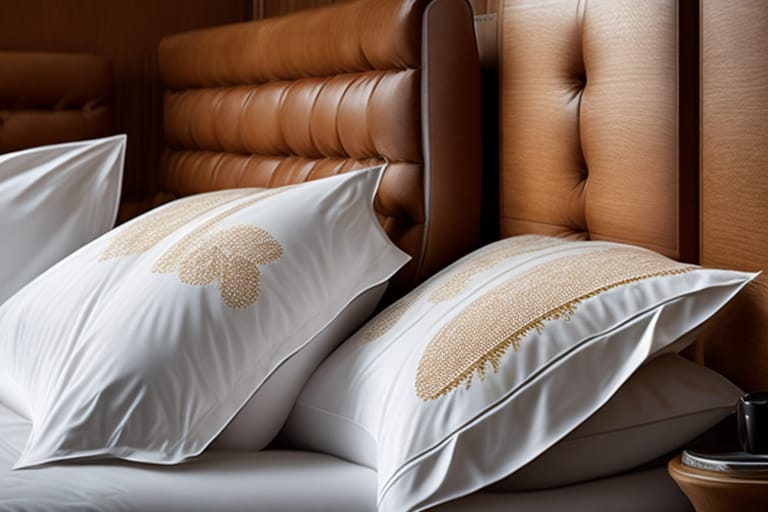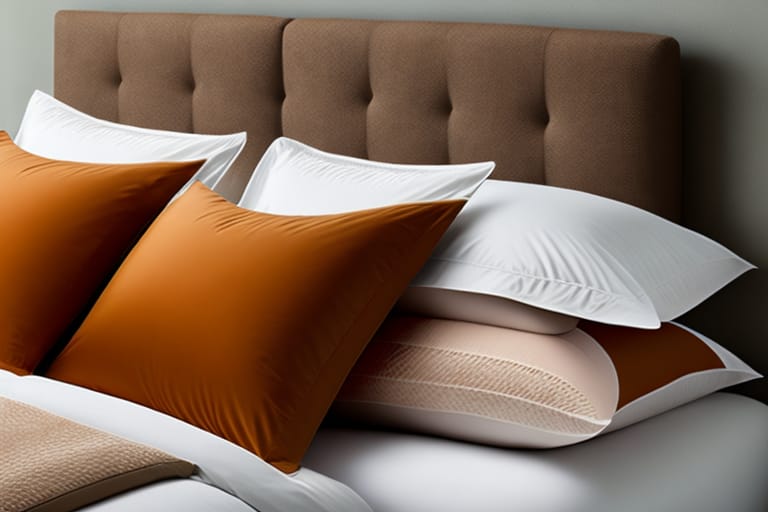Down comforters are renowned for their unbeatable warmth and plush comfort. But many comforter owners notice their down bedding gradually losing feathers and leaking over time. So do all down comforters leak feathers eventually?
While some feather leakage is inevitable, the rate and amount of feathers escaping from your comforter depends largely on its construction, fabric, maintenance, and quality. With proper care, high quality down comforters can retain feathers for many years with minimal leakage.
This beginner’s guide covers everything you need to know about identifying, preventing, and fixing down comforter feather leakage.
Why Do Feathers Leak from Down Comforters?
Down comforters contain delicate down clusters and feathers that are prone to escaping through small fabric holes or seams over time. The escape of feathers from your comforter is known as leakage. Here are the main causes of feather leakage:
- Normal wear and tear – Constant use inevitably causes tiny holes and thinning fabric allowing feathers to poke through. Filling shifts and compresses with use, putting strain on seams.
- Poor quality fabrics – Low thread counts, lightweight fabric, and lack of special downproof coatings cause premature leakage.
- Improper care – Insufficient fluffing and cleaning leads to matted down clusters, reducing loft and causing feathers to escape through gaps in the fabric.
Impacts of Down Comforter Feather Leakage
Allowing extensive leakage over many years has negative effects on your down comforter’s performance and lifespan:
- Reduced insulation – As more feather filling escapes, less is left within the comforter to trap heat and provide warmth.
- Loss of comfort – With reduced fill, your comforter becomes less fluffy and fails to properly cushion and conform to your body.
- Permanently deformed – Over time, areas depleted of feathers collapse and remain compressed even after fluffing.
- Shortened lifespan – Extensive loss of filling requires expensive restuffing and makes your comforter more difficult to repair.
Do All Down Comforters Leak Feathers?
The short answer is yes – all down comforters will leak small amounts of feathers with regular extended use. However, most quality comforters only leak minimal amounts that won’t significantly impact insulation or performance for many years.
Cheaply made comforters with low quality fabric and filling will leak feathers faster. But reputable brands construct comforters to minimize leakage well beyond normal lifespans.
So while all down comforters leak a bit eventually, models from quality brands with proper care will leak feathers at very slow rates.
How to Prevent Down Comforter Feathers from Leaking
You can prevent excessive feather leakage from your down comforter using these key methods:
Use a Duvet Cover
- A tightly-fitted duvet cover acts as an outer shell to contain feathers and prevent leakage through the comforter fabric.
- Sateen weave fabrics with tightly woven 400+ thread count cotton or microfiber work best to block feathers.
- Duvet covers should be laundered frequently, at least every 2 months along with your top bed sheet, to prevent buildup of body oils that can degrade cover fabrics over time.
Choose Fabrics with Special Downproof Finishes
- Look for down comforters listing special “downproof” fabric treatments like:
- Durable water repellant (DWR) coating
- Nanotex or other branded water resistance
- Tightly woven 400+ thread counts
- These coatings and super-tight weaves keep feathers contained within the baffles without reducing breathability or comfort.
- High quality Hungarian white goose down filled comforters typically use advanced downproof fabrics.
Frequently Fluff and Air Out Your Comforter
- To prevent matted, compressed areas in the filling from leaking feathers:
- Fully fluff and redistribute the down every 1-2 months.
- Allow your comforter to fully air out after use to dry moisture and loft filling.
- Use tennis balls in the dryer or bed aeration tools speed fluffing and drying.
- Wash down comforters 2-3 times per year max to avoid damaging filling and fabrics.

How to Identify if Your Down Comforter is Leaking Feathers
Check your down comforter and bedding routinely for signs of leakage:
- Visible feathers poking through the shell or baffle boxes, especially near seams
- Thin spots in the surface fabric where you can see filling through tiny holes
- Compressed, flat sections where insulation has shifted away leaving empty spaces
- Feathers accumulating inside duvet covers or bottom sheets
Catching leaks early makes repairs easier. But small amounts take years to impact performance.
Extensive leakage requires patching holes, restuffing flat sections, or comforter replacement if damage is too great.
How to Repair a Hole in Your Down Comforter
For minor leakage through small holes and thinning fabric:
- Use iron-on patches matched to your shell fabric to cover problem areas.
- Carefully hand-sew small stitches around patch edges to permanently seal.
For larger holes, missing seams, or leaks through quilted boxes:
- Cut fabric squares larger than each hole and align over the opening.
- Ladder-stitch around all 4 sides to seal feathers within boxes or channels.
When to Restuff a Flat Down Comforter Section
If flat, empty sections exceeding 16 inches across persist after fluffing:
- Source replacement down matching your comforter’s fill power.
- Carefully restuff empty channels with small handfuls of down per section using a spoon.
- Avoid overstuffing – slightly underfilled allows room for lofting.
For wispy European comforters, add an inner liner or replace the shell to prevent repeated leakage.
Differences Between Down and Feathers
Understanding differences between insulation materials helps choose optimal bedding:
- Down – Fluffy, soft clusters providing unmatched warmth and comfort from live-plucking waterfowl.
- Down offers the best warmth-to-weight ratio but lacks structure.
- Feathers – Firmer, structural plumes with central quill stems supporting softer vane fibers.
- More affordable and durable than down but heavier and less insulating per ounce.
Down excels at trapping heat, making it the gold standard for lightweight comforters and pillows. Feathers add structure and support better suiting thick mattress toppers.
How to Care for a Down Comforter
Follow these care practices to minimize wear and extend your comforter’s lifespan:
- Use a duvet cover – Adds a protective outer layer to contain feathers.
- Wash 2-3 times per year – Keeps down clean, lofty and free of dust and oils.
- Air out after use – Allows moisture from body heat to fully dry.
- Fluff monthly – Redistributes filling to prevent clumping and matting.
- Sun occasionally – UVs help naturally sanitize and renew loft.
- Store properly – Fold loosely or hang to allow down to decompress when not in use.
What Impacts Down Comforter Longevity?
A quality down comforter well cared for can retain its warmth, loft, and appeal for over 20 years. Several factors influence lifespan:
Plus performing repairs for leaks and holes extends a comforter’s usable life before needing replacement.

How to Choose a Long Lasting Down Comforter
Look for these hallmarks of a durable, leak-resistant down comforter when shopping:
- 100% white goose down – Holds loft better than duck down over decades of use
- Fill power of 600 or higher – Indicates larger, more resilient down clusters
- Baffled box construction – Prevents fill shifting and clumping over time
- Double needle stitching – Reinforces seams against popping from fill pressure
- Downproof cotton fabric – Densely woven 400+ thread count fabric
- DWR finish – Adds water resistance for enhanced leakage protection
A mid-weight, baffle box or diamond quilt down comforter from a top brand like Feathered Friends that meets these criteria coupled with proper care will retain fill integrity and provide cozy warmth for over 20 years.
Frequently Asked Questions
How often should you replace a down comforter?
With proper maintenance, a quality down comforter can last over 20 years. If purchasing a mid-range style, plan to replace every 8-12 years. Lower end comforters may only last 2-5 years before showing significant wear.
Why choose down over synthetic fill?
Down offers superior softness and the highest warmth-to-weight ratio of any fill material. It conforms more closely to your body shape for maximum comfort and insulation. When cared for properly, down maintains loft and performance better over time than alternative fills like polyester.
Can you put a down comforter in the dryer?
Most quality down comforters can be tumble dried on low heat for short cycles of 20 minutes or less provided the attached care label permits machine drying. Always air dry if unsure or if labeling recommends only air drying. Add tennis balls to break up clumping when drying.
Conclusion
While some feather leakage occurs with all down comforters eventually, choosing high quality construction paired with careful maintenance allows you to enjoy plush, cozy warmth from down comforters for over a decade before leakage is noticeable.
Protecting your down comforter with a duvet cover, washing regularly, properly air drying, and learning techniques to patch holes and restuff flattened sections will keep your comforter’s superior comfort and insulation intact for the long haul.
When evaluating new down comforters, examine baffle boxes, stitching, and shell fabrics closely and select options utilizing high fill power down contained within dense, downproof fabrics to experience heavenly softness and winter warmth for years before considering replacement.








